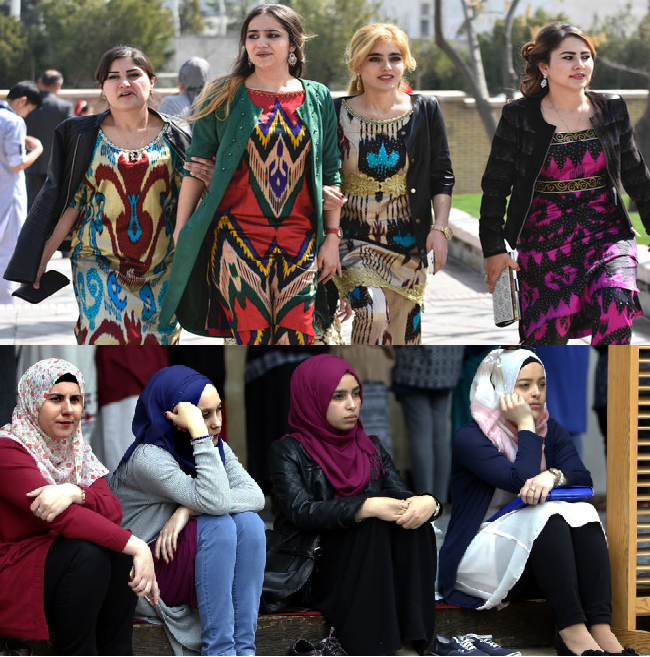
- The Tajikistan government has recently taken a significant step to safeguard its national culture and counteract what it perceives as the infiltration of “foreign” cultural aspects.
- The bill bans the use of hijabs and other attire considered “foreign” to Tajik culture in public establishments such as schools, colleges, and government buildings.
- Critics contend that implementing such policies may have adverse consequences, potentially exacerbating feelings of isolation and extremism among young individuals.
The Tajikistan government has recently made a noteworthy legislative decision by passing a bill that prohibits the wearing of the hijab and other “alien garments” in public areas. This action highlights the intricate interplay between cultural preservation, secular governance, and religious freedom within the country. This piece delves into the historical background, public and international responses, and wider consequences of this new legislation, providing insights into the delicate equilibrium that Tajikistan aims to uphold in shaping its national identity.
The Tajikistan government has recently taken a significant step to safeguard its national culture and counteract what it perceives as the infiltration of “foreign” cultural aspects. They have enacted legislation that prohibits the wearing of hijabs and other non-native attire in public spaces. This move has generated a diverse range of responses, both within the country and on the global stage, highlighting the intricate dynamics between culture, religion, and politics in the region.
Tajikistan, situated in Central Asia, is a country with a predominantly Muslim population. Throughout its history, Tajikistan has successfully managed to maintain a delicate balance between its Islamic traditions and the principles of secular governance. Following its independence from the Soviet Union in 1991, the nation has faced the complex task of nation-building within a diverse and multi-religious society. President Emomali Rahmon’s administration has consistently emphasized the significance of secularism and the development of a strong national identity. In doing so, they have expressed apprehensions regarding religious extremism and the potential impact of foreign cultural influences.
Throughout the years, the Tajik authorities have taken multiple steps to address the growing influence of radical Islam. In 2005, legislation was put into effect to limit religious practices and mandate religious organizations to officially register with the government. In 2015, an initiative was initiated to combat what the government referred to as “non-traditional” Islamic clothing, with a particular focus on the hijab. Additionally, the government prohibited children and adolescents from attending mosques and implemented stricter regulations on Islamic educational institutions.
The bill that was recently approved builds upon previous initiatives. It bans the use of hijabs and other attire considered “foreign” to Tajik culture in public establishments such as schools, colleges, and government buildings. While the law does not specifically refer to the hijab, the government’s historical actions and declarations make its purpose evident.
Advocates of the legislation assert that safeguarding Tajik’s cultural heritage and curbing the proliferation of extremist beliefs are crucial. They argue that the hijab, along with other comparable attire, is not inherent to Tajik customs but rather has been introduced by more orthodox Islamic communities. Additionally, the authorities have voiced worries about potential social disintegration stemming from the acceptance of various cultural and religious traditions.
The bill has received a variety of responses in Tajikistan. Certain sectors of the population endorse the measure, perceiving it as an essential measure to safeguard national culture and promote social unity. Nevertheless, numerous individuals, especially those belonging to the Muslim community, consider it a violation of their religious freedom and individual liberties. Women who choose to wear the hijab as a manifestation of their faith feel specifically singled out and excluded.
Criticism from human rights organizations and advocacy groups has been directed towards the legislation on an international scale. These entities contend that the ban infringes upon fundamental human rights, such as freedom of religion and expression. Both Amnesty International and Human Rights Watch have expressed their condemnation of the bill, urging the Tajik government to uphold its citizens’ rights to religious and cultural expression.
The approval of this legislation underscores the ongoing conflict in various regions worldwide between secular leadership and religious observance. In Tajikistan, this conflict is exacerbated by the government’s concerns about religious radicalism and the need to establish a unified national identity following the Soviet era. The government’s tactics mirror a larger pattern in Central Asia, where neighbouring nations have similarly enacted measures to regulate religious customs and curb the impact of external cultural and religious influences.
Critics contend that implementing such policies may have adverse consequences, potentially exacerbating feelings of isolation and extremism among young individuals. They propose that rather than enforcing prohibitions, governments should prioritize the development of inclusive measures that uphold religious liberties while fostering a sense of national cohesion.
The recent legislation in Tajikistan prohibiting the hijab and other “foreign” clothing marks a notable milestone in the nation’s continuous quest to establish its national identity and regulate religious practices. Although the government deems this law essential for safeguarding cultural heritage and curbing extremism, it prompts a critical examination of the delicate equilibrium between secularism and religious liberties. Observers from the global community, as well as human rights groups, will be monitoring the effects of this law on Tajik society and its wider ramifications on religious and cultural freedoms in the area.
